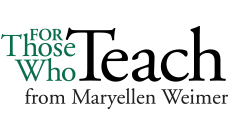I’m betting that many of you are in the midst of grading a large stack of papers, projects, or other final assignments. Too often these end-of-course pieces of work don’t live up to our expectations or students’ potential. It’s easy for us (especially the elders among us) to bemoan the fact that students aren’t what they used to be. It’s better to use our discontent to consider whether our course assignments are effectively accomplishing our course goals.
 As usual, my reading is what got me thinking about this topic. In this case it’s a new book by Paul Hanstedt on general education. He recommends that assignments for general education courses should achieve at least three things:
As usual, my reading is what got me thinking about this topic. In this case it’s a new book by Paul Hanstedt on general education. He recommends that assignments for general education courses should achieve at least three things:
- contain evidence that students are learning what we want them to be learning,
- engage students in deep, long lasting learning, and
- generate student work that doesn’t make us cry when we grade them. (p. 78)
It’s the example of his general education writing course focused on the social functions of art that made me see how clear the connection between assignments and course goals needs to be. He has four goals for his course. Students should be able to:
- write an effective essay using appropriate rhetorical methods given the audience and purpose,
- interpret individual responses to art,
- apply abstract concepts about art to particular works, and
- analyze the role art plays in contemporary life (p. 83)
To accomplish those goals he used to have students write three papers; one that analyzed a representational piece of art, pre-1850, a second that analyzed an abstract piece of art, post-1850; and a third that explored the role art should play in society. Okay assignments, but they didn’t produce work that showed students achieving the course goals all that well.
After making some changes, students are still writing three papers, but the assignments are very different. Now in the first paper, students analyze a piece of art that they like using the formal elements to explain their emotional response to it. They write this paper to a classmate as a way of introducing themselves. In the second paper, they use a quotation from the readings to justify the necessity of abstract art in contemporary society. They write this paper to a skeptical parent. For the third paper, students construct an argument justifying the use of university funds for the purchase of art, explaining the role they think art should play in academia. This final paper is addressed to the university president.
Here’s why these assignments better accomplish the course goals. Designating an audience for each paper forces students to assume authority for their knowledge and take on the task of explaining relevant concept and ideas to others. They aren’t writing so directly to and for the professor as when the audience wasn’t designated. The fact that the audience changes with every paper mirrors what happens in professional life. Professionals must deal with multiple audiences, customizing their message accordingly. Students also need to do research to write these kinds of papers, particularly the third one. And these papers do a much better job of showing the degree to which students understand and can apply course concepts. Finally, they give students the opportunity to make choices that are more personally relevant.
Does that mean students enjoy writing these papers? That’s probably a stretch, but there is a greater chance students might get engaged in the topics. And Hanstedt says these papers are definitely more interesting to read.
Right now you probably need to finish up that stack of whatever you’re grading, but as you do you might think a bit about your course goals. Is this particular assignment helping students accomplish them? Are there ways you could change the design that might align it more tightly to course goals? There’s great opportunity for creativity and innovation in the design of assignments and more faculty are taking advantage of that.
Reference: Hanstedt, P. General Education Essentials: A Guide for College Faculty. San Francisco: Jossey-Bass, 2012.